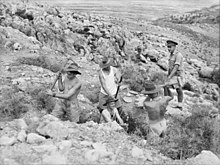25th Brigade (Australia)
| 25th Brigade (Australia) | |
|---|---|
 Men from the 2/25th Battalion cross the Brown River during a patrol in October 1942 | |
| Active | 1940–46 |
| Country | |
| Branch | Australian Army |
| Type | Infantry |
| Size | ~3,500 men |
| Part of | 7th Division |
| Engagements | Second World War |
| Commanders | |
| Notable commanders | Kenneth Eather |
The 25th Brigade was a brigade-sized infantry unit of the Australian Army that served during the Second World War. Raised in July 1940 and consisting of three infantry battalions, the 25th Brigade served in the United Kingdom, the Middle East, New Guinea and Borneo before being disbanded in 1946.
History
Raised in the United Kingdom in July 1940, the 25th Brigade was originally only intended to be a temporary response to the threat of an invasion by Germany following the Fall of France.[1] Initially it had an establishment of 1,759 men, of whom the vast majority were drawn from service support corps of the 6th Division, although roughly a quarter were drawn from infantry reinforcements that were diverted from joining their units which were at the time serving in the Middle East.[2]
Upon formation, the brigade consisted of only three infantry battalions instead of the four that had been the usual Australian establishment up to that time,[1] due to manpower shortages and its component units were the 70th, 71st and 72nd Battalions, although these were later re-designated as the 2/31st, 2/32nd and 2/33rd Battalions.[2]
Originally the 25th Brigade was part of the newly established 9th Division, however, after being dispatched to the Middle East in 1941 it was transferred to the 7th Division, with which it remained for the rest of the war.[2] By May, its establishment was completed, and it consisted of 3,500 men[3] and was composed of the 2/25th, 2/31st and 2/33rd Battalions.[4]
After this the brigade took part in the Syria–Lebanon campaign in June–July 1941, during which it fought against the Vichy French before undertaking garrison duties after the armistice was signed.[5]

In early 1942, following Japan's entry into the war and concerns about the strategic situation in the Pacific, the 25th Brigade—along with the rest of the 7th Division—were brought back to Australia to help reinforce the Militia units that were trying to hold back the Japanese advance in New Guinea.[5] Between September 1942 and February 1944 the brigade took part in a number of battles as part of the fighting in New Guinea, albeit broken up by a period of six months of home service in Australia.[6] Some of the brigade's most significant battles were at Kokoda, Buna–Gona, Lae and Shaggy Ridge.[7][8]
In February 1944 the brigade returned to Australia where they remained for over a year training in Queensland before taking part in the final western Allied amphibious operation of the war—the Landing at Balikpapan in July 1945.[9][10] This operation was part of the wider Borneo campaign. The strategic value of this campaign has since been questioned, however, ultimately the 25th Brigade's involvement in it was successful and it proved their last involvement in the war.[2][9]
It was disbanded shortly thereafter in 1946.[2]
Notes
- ^ a b Dickens 2005, p. 367.
- ^ a b c d e "25th Brigade". Australian War Memorial. Retrieved 18 October 2009.
- ^ Dickens 2005, p. xiii.
- ^ Johnston 2007, p. 43.
- ^ a b Johnston 2007, p. 44.
- ^ Draydon 2000, pp. 109–199.
- ^ Bradley 2004.
- ^ Johnston 2007, pp. 44–46.
- ^ a b Johnston 2007, p. 32.
- ^ Draydon 2000, p. 237.
References
- Bradley, Phillip (2004). On Shaggy Ridge—The Australian Seventh Division in the Ramu Valley: From Kaiapit to the Finisterres. South Melbourne, Victoria: Oxford University Press. ISBN 0-19-555100-1.
- Dickens, Gordon (2005). Never Late: The 2/9th Australian Infantry Battalion 1939–1945. Loftus, New South Wales: Australian Military History Publications. ISBN 1-876439-47-5.
- Draydon, Allan (2001) [2000]. Men of Courage: A History of 2/25 Australian Infantry Battalion 1940–1945. Loftus, New South Wales: Australian Military History Publications. ISBN 0-646-38663-8.
- Johnston, Mark (2007). The Australian Army in World War II. Botley, Oxford: Osprey Publishing. ISBN 978-1-84603-123-6.
